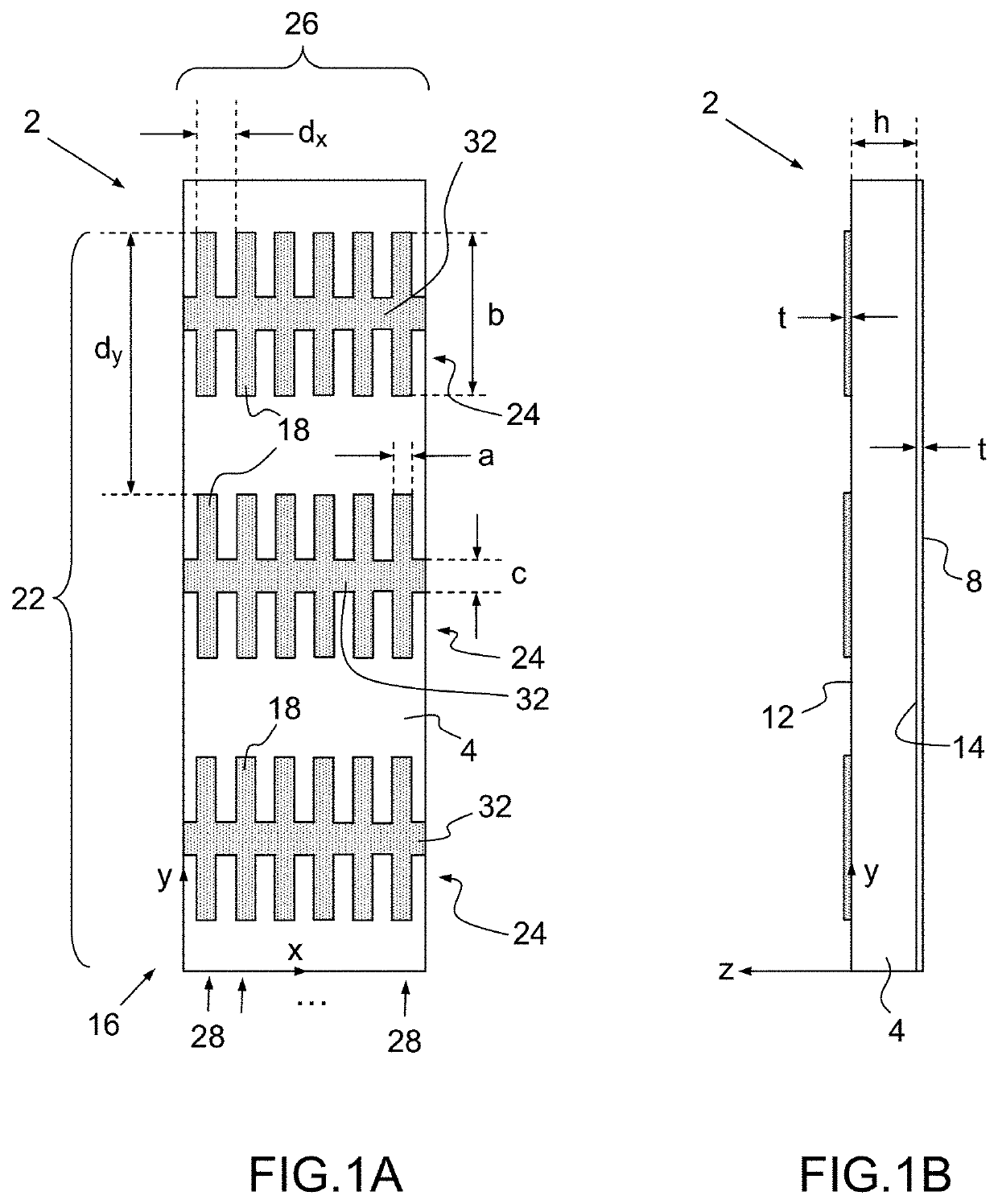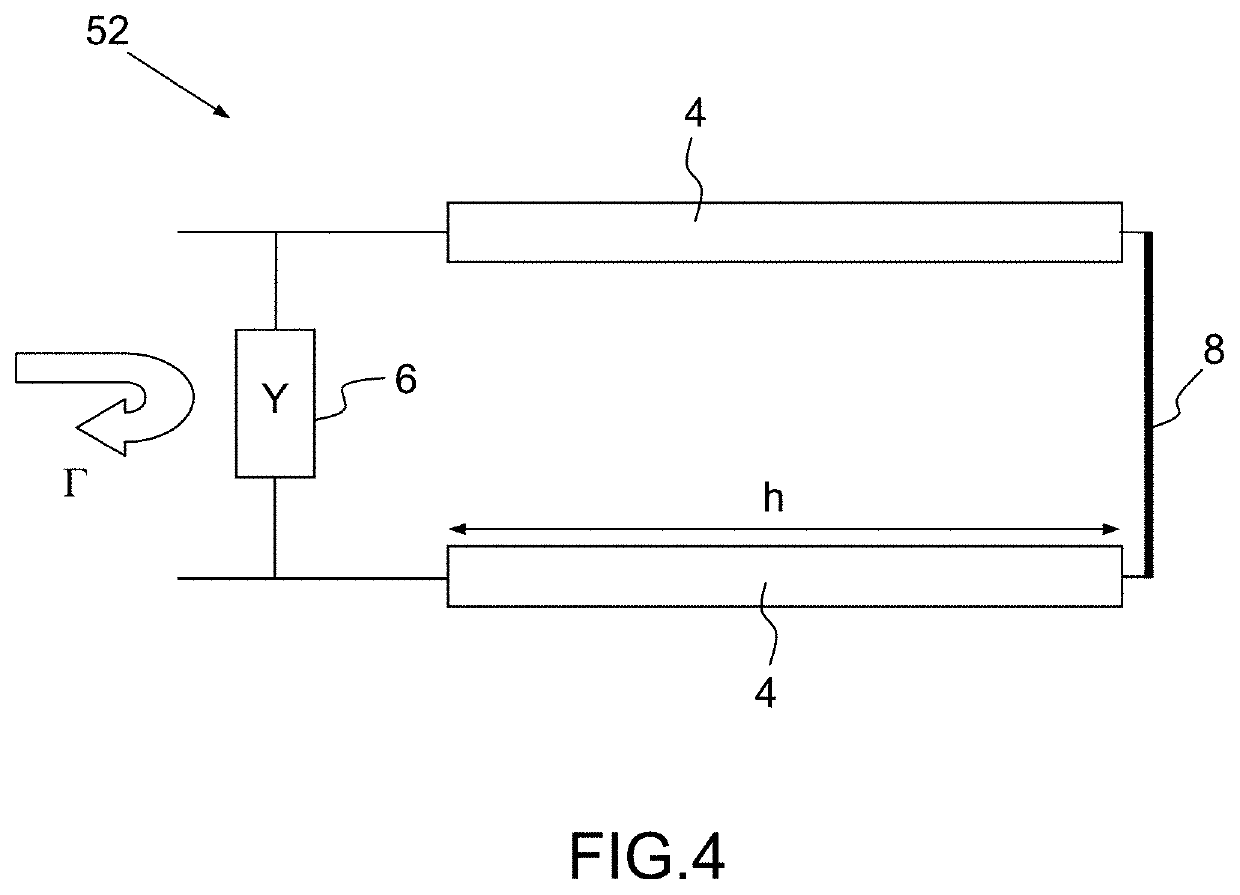Polarizing reflector for multiple beam antennas
a technology of reflectors and antennas, applied in the direction of antenna earthings, antennas, electrical devices, etc., can solve the problems of reducing affecting the polarization efficiency of the antenna, and affecting the polarization efficiency of the circular polarization
- Summary
- Abstract
- Description
- Claims
- Application Information
AI Technical Summary
Benefits of technology
Problems solved by technology
Method used
Image
Examples
first embodiment
[0090]According to the FIGS. 1A-1B and the invention, a polarizing reflector 2 suited to broadband satellite applications is configured for converting a same linear polarization into a given circular polarization handedness over one frequency band, or into a given circular polarization handedness over a first frequency band and into the orthogonal handedness over a second frequency band.
[0091]The polarizing reflector 2 comprises a flat dielectric substrate 4, a patch array layer 6 and a ground layer 8.
[0092]The flat dielectric substrate 4 is delimited between a first surface 12 and a second surface 14, having a thickness h and a dielectric permittivity εr.
[0093]The patch array layer 6 is formed by a bi-dimensionally periodic lattice 16 of thin metallic patches 18 laid on the first surface 12 of the substrate 4, the periodic lattice 16 having a first set 22 of patch rows 24 oriented along a first direction x with a periodicity dx and a second set 26 of patch columns 28 oriented along...
second embodiment
[0156]According to FIG. 13 and the invention, a polarizing reflector 213 suited to broadband satellite applications is configured for converting a same linear polarization into a given circular polarization handedness over one frequency band, or into a given circular polarization handedness over a first frequency band and into the orthogonal handedness over a second frequency band.
[0157]The polarizing reflector 213 comprises a flat dielectric substrate 214, a patch array layer 216 and a ground layer 218.
[0158]The flat dielectric substrate 214 is delimited between a first surface 222 and a second surface 224, having a thickness h and a dielectric permittivity εr.
[0159]The patch array layer 216 is formed by a first bi-dimensionally periodic lattice 226 of thin metallic patches 228 and a second bi-dimensionally periodic lattice 230 of thin metallic patches 228, both laid on the first surface 222 of the substrate 214.
[0160]The first and second periodic lattices 226, 230 having each a fi...
third embodiment
[0182]According to the FIG. 16 and the polarizing reflector, a flat polarizing reflector 352 for a broadband antenna is locally illuminated at normal or oblique incidence by an electromagnetic source 354 (or feeder) having a predetermined radiation pattern to the flat polarizing reflector.
[0183]The flat polarizing reflector 352 is configured for converting locally a linear polarization Einc into a given local circular polarization handedness over one frequency band when operating in a single wideband at a local normal or oblique incidence illuminated by a local plane wave originated from a predetermined radiation source pattern, or into a first local circular polarization handedness over a first frequency band and into a second local polarization handedness over a second frequency, the first and the second local circular polarization handedness being substantially equal or orthogonal when operating in dual-band at normal or oblique incidence illuminated by a local plane wave origina...
PUM
 Login to View More
Login to View More Abstract
Description
Claims
Application Information
 Login to View More
Login to View More - R&D
- Intellectual Property
- Life Sciences
- Materials
- Tech Scout
- Unparalleled Data Quality
- Higher Quality Content
- 60% Fewer Hallucinations
Browse by: Latest US Patents, China's latest patents, Technical Efficacy Thesaurus, Application Domain, Technology Topic, Popular Technical Reports.
© 2025 PatSnap. All rights reserved.Legal|Privacy policy|Modern Slavery Act Transparency Statement|Sitemap|About US| Contact US: help@patsnap.com



